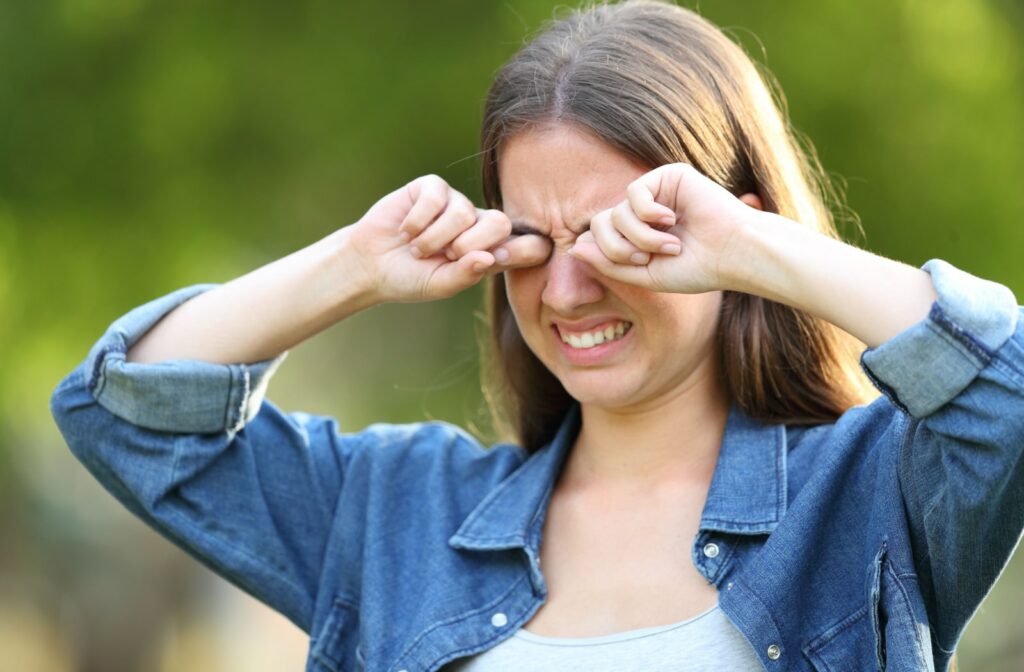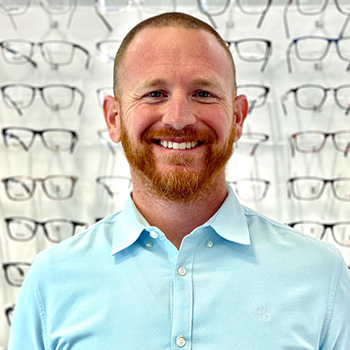They say the eyes are the windows to the soul. But what happens when those windows are constantly plagued with irritation, dryness, and itchiness? We rely on our eyes for a lot to get us through the day. Uncovering the cause of your discomfort is the first step to finding relief, and your optometrist is well-equipped to help with comprehensive eye exams.
Aging, medications, allergies, and hormonal changes are only some factors that could lead to dry eye disease, the primary cause of dry and itchy eyes.
What Is Dry Eye Disease?
There’s more to your tears than meets the eye, and each blink you take creates a tear film that helps your eyes stay nourished and moist. Your tear film isn’t just water, either. Instead, it has 3 layers working in harmony:
- The inner mucus layer helps your tears stick to your eyes
- The watery middle layer helps hydrate your eyes and is the thickest layer
- The outer oily layer helps prevent the other layers from evaporating too fast
If something disrupts your tear film, your eyes can be left unprotected and potentially cause the dry, itchy sensation you’re experiencing. Other symptoms that may indicate dry eyes are to blame for your irritation include:
- General eye discomfort and irritation
- A burning or stinging sensation
- Light sensitivity
- Red eyes
- Blurry vision
- Difficulty wearing contact lenses
- The feeling of something being stuck in your eye
- Excessive tear production without relief
What Causes Dry Eyes?
There are 2 types of dry eye disease:
- Aqueous deficiency dry eye
- Evaporative dry eye
Aqueous deficiency dry eye occurs when you aren’t producing enough tears to keep your eyes hydrated. Some medical conditions and hormonal changes can affect tear production, but people also generally produce fewer tears as they age.
Evaporative dry eye is much more common. It’s normally caused by meibomian gland dysfunction (MGD), accounting for around 85% of all dry eye cases. The meibomian glands line your eyelids and are responsible for creating your tear film’s oily layer. If they become inflamed or blocked, your tears may evaporate too fast.
Factors that can increase your risk of developing either type of dry eye disease include:
- Age: Most people over 65 develop dry eyes at some point.
- Hormonal changes: Women are more likely to experience dry eyes.
- Environmental conditions: Windy, smoky, hot, or dry environments could increase tear evaporation.
- Medications: Antihistamines, decongestants, blood pressure medication, and antidepressants are all linked to reduced tear production.
- Medical conditions: Some diseases can affect tear production, such as Sjogren’s syndrome, rheumatoid arthritis, thyroid problems, and diabetes.
- Overuse of contact lenses: Contact lenses can absorb moisture from your eyes.
- Excessive screen time: People tend to blink less while working on digital screens, contributing to dry eyes.
Eye Allergies & Dry Eyes
Eye allergies, also known as allergic conjunctivitis, are a common condition that affects millions of people worldwide. They happen when your eyes are exposed to an allergen, which could be anything from dust, pollen, pet dander, or mold spores. As a result, your immune system reacts by releasing histamine, which causes inflammation and itching in your eyes.
This condition is further complicated by the fact that antihistamines, which are generally used to treat allergies, can also cause dry eyes. If you’re a chronic sufferer of dry eyes dealing with seasonal allergies, you should talk to your eye doctor about a treatment that won’t potentially make your symptoms worse.
Treatments for Dry Eye Disease
Dry eye disease symptoms can range from mild to severe, and your optometrist could personalize your treatment plan to match your needs. Sometimes, the simplest solution is the best one for you, and not everyone needs an intricate, multi-step process.
The medical community has come a long way in our understanding of dry eye disease over many decades. Some treatments for dry eyes may include:
- Artificial tears: One of the most common and convenient treatments for dry eye disease is artificial tears. These eye drops mimic the natural tears to provide relatively quick and temporary relief of dryness and irritation.
- Puntal plugs: Punctal plugs are tiny devices inserted into the tear ducts to block tear drainage. This can help to keep the tears on the surface of the eyes. They are easy to insert and are usually not felt by the patient.
- Omega-3 supplements: Studies have shown that omega-3 fatty acids can help maintain a healthy tear film. These nutrients are primarily found in coldwater fish, but if you have a deficit, a doctor may suggest fish oil supplements to support healthy tears.
- Lipiflow: LipiFlow is a noninvasive treatment that uses gentle heat and pressure to unclog the meibomian glands. LipiFlow can improve the quality of tears and reduce the symptoms of dry eye disease. Many people find the process soothing, as they can sit back and enjoy the in-office eye massage.
- Lid & lash care products: Foaming cleansers, makeup removers, and eyelid scrubs are specially formulated with natural ingredients such as tea tree oil, which helps to reduce inflammation and soothe irritation around the eyes.
- Heat masks: These masks are designed to provide fast relief for dry eyes at home by increasing blood flow and improving tear production. They’re relatively simple to use and can be heated in a microwave to help soften oil blockages in your eyes.
Rejuvenate Your Eyes
Experiencing dry and itchy eyes can be a nuisance, but fortunately, the experienced team at Dr. Bittel Optometry has the tools and knowledge to help ease your symptoms. Our dry eye rejuvenation program can help you find comfort in your sight and see a world past dry and itchy eyes.
Let us make a difference in your life. Book your appointment today and ask about dry eye relief!


